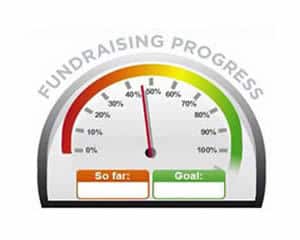
Specific and Achievable Fundraising Goals Help You Raise More Funds!
Fundraising goal setting is a year-round process. You’ll need to evaluate your own past performance, and think reasonably about what you can accomplish by next year. A good fundraising goal has a formal plan—some pen and paper tasks you can check off to monitor your progress.
Determine a clear set of action steps to achieve each goal, and establish specific and detailed ways to measure your benchmarks. Your fundraising goals should have quantifiable and achievable results.

In your fundraising goal planning meetings:
- Analyze what worked and what didn’t
- Set realistic, achievable goals
- Create a detailed plan for how to achieve that goal
- Set progress benchmarks and work incrementally toward your goal
- Celebrate and reward successes
1. Data Collection
If you think planning for your next event doesn’t start until after this year’s auction-day chaos is over, we have a surprise. The best way to set ambitious goals—and meet them—is to start thinking about it before this year’s auction is over.
Decide what post-event reports you’ll want to see, and what donor data your event management software will need to run it. Collect guest information for new people at your event. Code your items and collect sales information to measure their performance later.
- What types of items sold near or over the item value? (The highest ROIs?)
- How many guests were new supporters versus returning supporters? Where did the new ones come from, and how can we maximize that reach?
2. Post-event Evaluation
Think about non-quantifiable goals, too. Have a post-event meeting about your experiences—what worked and what didn’t.
- How many volunteers did you have? How effective were they?
- What was most effective in securing sponsorships? How many calls did you make, how many meetings did you have?
- Evaluate the professionals you hired, e.g. your auctioneer. Would you hire the same individuals next year?
3. Determine Your Priorities
You can’t do everything every year, or you’ll burn out. Focus on what your organization needs most moving forward and design your goals around those priorities.
Are you a smaller or newer organization looking to build your donor base? Focus on outreach and media. Or do you have an established supporter pool and want to increase engagement? Add online bidding or online auctions for a future-forward image. (Set a goal to make more asks and get a local tech business to sponsor it.)
4. Setting Specific, Achievable Goals
Hold a planning meeting with your team and your collected data: now we know how we did. What will we do next year?
Write your fundraising goals in terms of performance. Let’s say you want to increase your total auction sales. Which item categories performed the best? Say, “Let’s get more of those next year.”
Instead of supposing, “We need to get more dollars from attendance,” consider extending your reach. Set your goal at getting your message to five outlets instead of the three from last year.
Each fundraising goal you set needs two things:
- A clear scope. Set goals that are reasonable and achievable—bars you think you can meet. Suggest your committee members set their own goals. Push yourself to make more connections and ask for those big items and sponsorships. Small victories keep fundraisers engaged and pushing to do more.
- Small, actionable steps. Break down the fundraising goal into tasks you can get out and start doing immediately. Instead of saying, “We want to raise $10,000 more dollars in sponsorships,” lay out some specific steps for how you’ll get there.
For example, increasing your number of sponsor asks. It’s a quantifiable goal you can strategize around. Encourage everyone making calls and setting up meetings. Dollars start with asking for them.
5. Celebrate Fundraising Goal Successes
What’s the great part about having a formal plan and specific, itemized benchmarks? The satisfaction of checking things off the list.
Celebrate when you get closer to your goal. Thank people for their work. Reward yourselves for a job well done!


One Response to “5 Steps to Creating Better Fundraising Goals”